|
|
|
Sort Order |
|
|
|
Items / Page
|
|
|
|
|
|
|
| Srl | Item |
| 1 |
ID:
091712
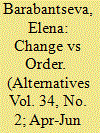

|
|
|
|
|
| Publication |
2009.
|
| Summary/Abstract |
This article examines how China, understood as a construct made up of multiple identities, constantly negotiates its relationships with the world. The oppositions-between tradition and modernity, the past and the present, China and the West-that are often presumed or reproduced in our thinking about China's place in the world are called into question. China's relationship with the world must be understood through the interplay between history and present, and thus through the particular uses of history in practice. The article especially explores how the world and China's place in it are seen in Chinese popular culture and visual expressions of state initiatives to promote Chinese culture. It focuses on the way images of the ever-changing world are depicted in two visual narratives: a promotional video of the Confucius Institute and the film The World (Shijie)
|
|
|
|
|
|
|
|
|
|
|
|
|
|
|
|
| 2 |
ID:
152358
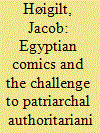

|
|
|
|
|
| Summary/Abstract |
Adult comics are a new medium in the Arab world. This article is the first in-depth study of their emergence and role within Arab societies. Focused on Egypt, it shows how adult comics have boldly addressed political and social questions. Seeing them as part of a broader cultural efflorescence in Egypt, I argue that, against patriarchal authoritarianism, adult comics have expressed an alternative ideology of tolerance, civic rights and duties, individualism, creativity, and criticism of power. Specifically, they present a damning critique of Egypt's authoritarian order, as well as of the marginalization of women and broader gender dynamics in Egyptian society. Through frank humor, a playful style, and explicit graphics, they give voice to the concerns of young Egyptians. Connecting comics to other art forms such as music, graffiti, and political cartoons, I situate them within a critical cultural movement that came to the fore with the Egyptian uprising of 2011.
|
|
|
|
|
|
|
|
|
|
|
|
|
|
|
|
| 3 |
ID:
170470
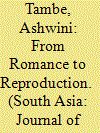

|
|
|
|
|
| Summary/Abstract |
This essay takes up for analysis how couples were represented in the cover art of the Marathi women’s magazine, Stree, from 1935 to 1965. Stree was the longest continuously running women’s magazine in Marathi (published from 1930 to 1986) and had a strong visual identity that benefited from cover images painted by noted artists. I focus here on a contrast that is evident between how couples were represented before and after Independence. Between 1935 and 1947, the hallmark image on the covers was the romantic couple, with alluring women as central figures. After Independence, between 1947 and 1965, the romantic couple receded from view and was replaced by scenes of comfortable and responsible mothering and domesticity. Depictions of premarital romance dropped, and women became components in a household tableau rather than the focus of romantic pursuit. In contrast with the Anglicised notions of glamour used in the 1930s, we also find a more explicitly Hindu aesthetic in the frequent representations of religious rituals and weddings. I treat these changing themes as an expression of the visual idiom of nation-building in mid twentieth century India. The increasing Hinduisation of couples in Stree covers reflects a post-Partition ethos of channelling conjugality along specifically majoritarian religious lines. The shunning of frivolity and the turn towards family and nation-building in this cultural text illustrates, in effect, how nationalism can shore up and promote very segregated gender relations.
|
|
|
|
|
|
|
|
|
|
|
|
|
|
|
|
| 4 |
ID:
122906
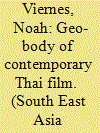

|
|
|
|
|
| Publication |
2013.
|
| Summary/Abstract |
Contemporary Thai films such as Salween (Chatrichalerm Yukol, 1995), Handle Me With Care (Kongdej Jaturanrasamee, 2008) and Mysterious Object at Noon (Apichatpong Weerasethakul, 2000) emphasize connections between geographical space and national belonging in unconventional ways. By employing new creative techniques to present continuing political conflicts in the region, these films lay claim to a visual tradition of territorial recognition. This article interprets this recent cinematic direction as a continuation of Thongchai Winichakul's critique of the 'geo-body'. The geo-body, a conceptual framing that links seeing subjects with visual representations, enables the imagination of national space by mapping bodies. This article shows how the aesthetic techniques of film reorient the imagination of national space through a reconfiguration of the geo-body of film.
|
|
|
|
|
|
|
|
|
|
|
|
|
|
|
|
| 5 |
ID:
182944
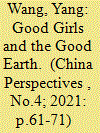

|
|
|
|
|
| Summary/Abstract |
During the most robust years of his career, 1949 to 1964, the artist Shi Lu 石魯 (1919-1982) frequently painted young rural women. The appearance of peasant women in the art of the early Maoist period ostensibly demonstrates the suitability of the subject for visualising state policies that promoted social transformation and women’s liberation. While participating in these nation-building efforts, Shi Lu’s images of peasant women were also a product of global art historical influences, namely allegorical depictions, that manifested subtle influence on the development of twentieth-century Chinese art. The identity of the artist, a Yan’an cadre who provided creative and administrative support to the official art system, reveals how artists navigated political expectations as state functionaries while simultaneously defining them through artistic exploration. Through the case study of Shi Lu and the hybridised global artistic traditions that gave rise to the subject of young peasant women in Maoist China, this article reveals the porousness of an era that has been considered isolated from global currents outside of the Soviet sphere.
|
|
|
|
|
|
|
|
|
|
|
|
|
|
|
|
| 6 |
ID:
174148
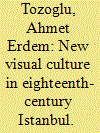

|
|
|
|
|
| Summary/Abstract |
This article examines the construction and expansion of a less-known royal shore kiosk complex in Istanbul, namely the Shore Palace near the Cannon Gate (Topkapısı Sahil Sarayı) or Summer Harem, which was built on the outskirts of the royal palace complex in the eighteenth century, to interpret the changing features of royal residential culture and spatial practices. In this article, I aim to propose a new thematic frame based on the central role of the issue of visuality to examine the shifting cultural paradigm of eighteenth-century royal patronage. The eighteenth century witnessed the physical expansion of the complex and renovation of the furnishings several times and the official records of these activities provide us with invaluable information for the visual construction of these buildings, which were torn down after a devastating fire in 1862. Furthermore, the choice of location and all physical changes in the interiors and gardens demonstrate the spatial results of the changing codes of visual culture in the cityscape. In this respect, examination of this case enables us to discuss how the new visual culture was adopted and exercised in and around the royal palace gardens by the royal court members.
|
|
|
|
|
|
|
|
|
|
|
|
|
|
|
|
| 7 |
ID:
139446
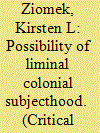

|
|
|
|
|
| Summary/Abstract |
This article examines whether writing histories of colonial subjects is possible. Traditional colonial histories subsume the colonial subject's individual history under a larger narrative of subjugation, which often does not allow room for people to exist outside the dichotomized role of collaborator/resister. This approach has left a gap in the scholarship for histories of colonial subjects whose lives do not easily fit either category. This article addresses this gap by detailing the life of Yayutz Bleyh, an Atayal woman who became one of the most important participants in the Japanese colonial administration of Aboriginal Affairs in Taiwan. For over six years, the author gathered fragmented pieces of information regarding Yayutz from a multitude of sources – visuals, as well as oral and written materials from inside and outside the colonial archive – in order to sketch the contours of an extraordinary woman and her life. Through the process of filtering these disparate sources, it was the silences regarding certain issues and the discrepancies that emerged among sources that proved to be the most revealing about Yayutz as someone who straddled both the world of the colonizer and the colonized.
|
|
|
|
|
|
|
|
|
|
|
|
|
|
|
|
| 8 |
ID:
149778
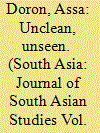

|
|
|
|
|
| Summary/Abstract |
Successive Indian governments have attempted to tackle the formidable task of creating a clean India, with varied results. With the country's rapidly growing middle class eager to participate in a sanitised global consumer capitalism, many Indians are becoming frustrated with the ‘unruly’ nature of their urban landscape, its dirty streets and public spaces. This is particularly discernible amongst India's middle-class youth, who seem impatient with the state's apparent inability to manage waste and disorder, and it is clear that several civil society campaigns designed to promote a clean India explicitly target Indian youth. In this paper, I explore what the ideological premise of cleansing initiatives reveals about the aspirations, needs and anxieties of India's youth.
|
|
|
|
|
|
|
|
|
|
|
|
|
|
|
|
| 9 |
ID:
117863
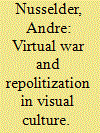

|
|
|
|
|
| Publication |
2012.
|
| Summary/Abstract |
This article discusses Andrew Hill's book Re-imagining the war on terror with a special attention to the unconscious mental dimension of the conflict. Clarifying this symbolic, signifying dimension can help us to traverse the fantasies that we are so easily trapped in. Thus it opens the way for introducing a moral and political position in the War on Terror and in visual culture in general.
|
|
|
|
|
|
|
|
|
|
|
|
|
|
|
|
|
|
|
|
|